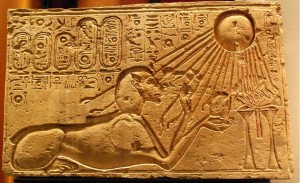The Amarna period, roughly 1353-1336 BCE, introduced a new form of art that completely contradicted what was known and revered in the Egyptian culture. The pharaoh Amenhotep IV not only changed his name from Amenhotep to Akhenaten, and the religion of ancient Egypt from polytheistic to monotheistic, but he also challenged the norm of Egyptian society by depicting his reign in a vastly different way from the rulers who came before him. Previous to Akhenaten’s rise to the throne, Egyptian art was stagnant, focused heavily on permanence both of the object and of the subject (most pertinently, the pharaoh) itself.
– See more at: http://www.ancient-origins.net/ancient-places-africa/art-amarna-akhenaten-and-his-life-under-sun-002587#sthash.snOFoSNe.dpuf
For more info – http://www.penn.museum/sites/amarna/about2.shtml.#sthash.snOFoSNe.dpuf



He really came in and shook up the place, didn’t he? But when the next paroahh abandoned Akhenaten’c capital city and returned to the usual Egyptian capital, it was easy to destroy a lot of the monuments and artwork.